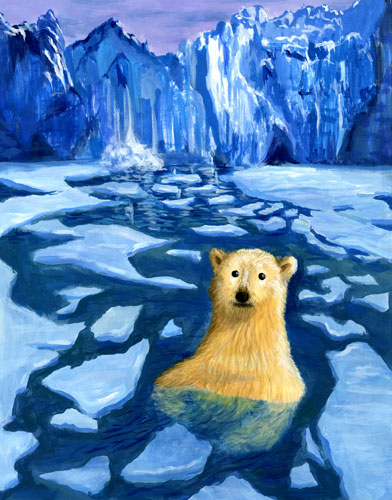 Overcast with occasional sprinkles this early Sunday on California’s north coast, with more rain expected to spatter-through later today.
Overcast with occasional sprinkles this early Sunday on California’s north coast, with more rain expected to spatter-through later today.
Last week,the NWS released preliminary rainfall totals for November — a bit better than last year (5.30-inches vs 5.11 in 2014), but well under the average for a ‘normal‘ month (6.73-inches).
Not much in the way of ‘normal’ weather nowadays. Terrible now-normal extremes over the holidays, killing 24 people the last three days, including 11 yesterday around Dallas, Texas, when ‘a swath of tornadoes‘ ripped across the area.
Meanwhile, another indicator of the ‘new normal‘ via Climate Central: ‘It said there was a high probability that “the global polar bear population will decline by more than 30 percent over the next 35 to 40 years”, broadly reaffirming findings from 2008.’
(Illustration found here).
The cause, of course, is the melting ice:
Polar bear numbers have risen in some regions in recent years because of better protection and bans on hunting, but estimates of overall populations from past decades are vague.
The shrinkage in sea ice, which in September 2012 was the most severe since satellite records began, will make it ever harder for polar bears to catch seals that live on the ice, the report said.
The IUCN said a Red List of animals and plants that it compiles found that 23,250 species were endangered of 79,837 assessed so far.
Polar bears are listed as “vulnerable,” the least endangered category on a scale that ends with “extinct.”
The whole polar region is melting away. A couple of weeks ago, an update of the situation (via the Guardian):
The Arctic experienced record air temperatures and a new low in peak ice extent during 2015, with scientists warning that climate change is having “profound effects” on the entire marine ecosystem and the indigenous communities that rely upon it.
The latest National Oceanic and Atmospheric Administration (Noaa) report card on the state of the Arctic revealed the annual average air temperature was 1.3C (2.3F) above the long-term average — the highest since modern records began in 1900.
In some parts of the icy region, the temperature exceeded 3C (5.4F) above the average, taken from 1981 to 2010.
This record heat has been accompanied by diminishing ice.
The Arctic Ocean reached its peak ice cover on 25 February — a full 15 days earlier than the long-term average and the lowest extent recorded since records began in 1979.
The minimum ice cover, which occurred on 11 September, was the fourth smallest in area on record.
More than 50 percent of Greenland’s huge ice sheet experienced melting in 2015, with 22 of the 45 widest and fastest-flowing glaciers shrinking in comparison to their 2014 extent.
And the problem isn’t just existence of polar bears and such, but gas leakage, methane gas — the other ‘meth.’ Less of it, but it packs a global-warming punch: ‘Pound for pound, the comparative impact of CH4 on climate change is more than 25 times greater than CO2 over a 100-year period.’
Coincidentally, hidden away under all that melting polar ice is a shitload of methane. And hence, another worse-than-previously-predicted study on the matter — from Harvard.edu:
Scientists from SDSU, NASA’s Jet Propulsion Laboratory (JPL), the Harvard John A. Paulson School of Engineering and Applied Sciences (SEAS), the University of Montana, and the National Oceanic and Atmospheric Administration, found that far more methane is escaping from Arctic tundra during the cold months when the soil surface is frozen (generally from September through May), and from upland tundra, than climate modelers previously believed. In fact, the researchers found that at least half of the annual methane emissions occur in the cold months, and that drier, upland tundra can be larger emitters of methane than wet tundra.
The finding challenges critical assumptions in current global climate models.
The results are published today in the Proceedings of the National Academy of Sciences (PNAS).
Methane is a potent greenhouse gas that intensifies atmospheric warming and is approximately 25 times more potent per molecule than carbon dioxide over a 100-year period.
Methane trapped in the Arctic tundra comes primarily from microbial decomposition of organic matter in soil that thaws seasonally.
This methane naturally seeps out of the soil over the course of the year, but scientists worry that climate change could lead to the release of even larger emissions from organic matter that is currently stabilized in a deep, frozen soil layer called permafrost.
Meanwhile, this with a lot of tundra space (via Phys.org): ‘Russia is warming more than twice as fast as the average for the rest of the world, the environment ministry said Friday, sounding an alarm on the rise in floods and wildfires nationwide.’
Polar bears and tornadoes…